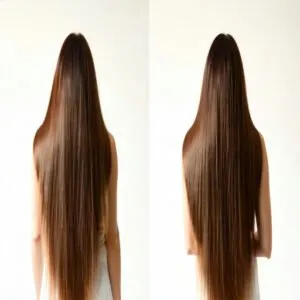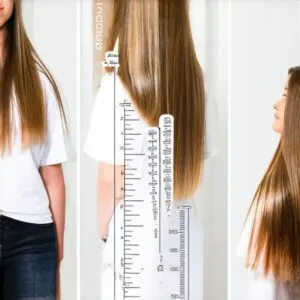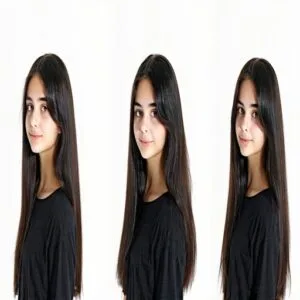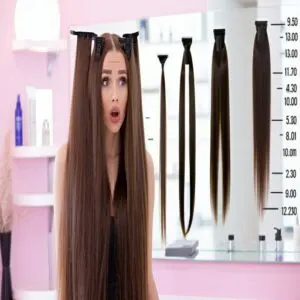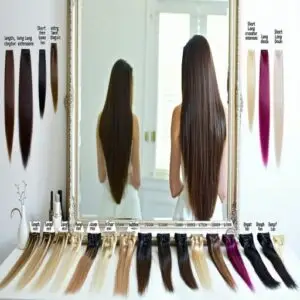This site is supported by our readers. We may earn a commission, at no cost to you, if you purchase through links.
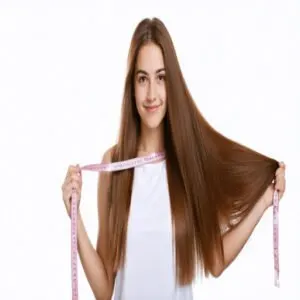
Grab a soft measuring tape and place it at the middle of your scalp, right at the front hairline.
Guide the tape along your hair’s natural fall until you reach the very tip of the longest strand—don’t stretch the hair to avoid errors.
Compare your measurement to a hair length chart, which typically references body parts like shoulders or waist for clarity.
Measuring regularly helps track growth or pick the right hair extensions.
Want precision?
Length-check T-shirts or photos can simplify the process and keep it fun!
Table Of Contents
- Key Takeaways
- Hair Length Categories
- How to Measure Your Natural Hair Length
- Measuring Hair Length by Body Parts
- Length Check T-shirts
- Comparison Shots
- Tips for Choosing The Correct Length of Hair Extensions
- Clip-in Hair Extension Length Guide
- Frequently Asked Questions (FAQs)
- How do I measure the length of my hair?
- How do you work out your hair length?
- How is hair length determined?
- How do you know what length of hair suits you?
- How can I measure my hair length accurately if I have layers or bangs?
- What are some common hairstyles for short hair lengths?
- How do I measure layered hair lengths?
- What tools work best for curly hair?
- How does shrinkage affect hair length measurement?
- Can I track hair growth without cutting?
- Conclusion
Key Takeaways
- Use a soft measuring tape starting at your front hairline and follow your hair’s natural fall to the tips without stretching it for accurate results.
- Hair length charts simplify tracking growth and selecting styles by referencing body parts like shoulders or waist for clarity.
- Length-check t-shirts and comparison photos make it easy to monitor progress consistently and visually track your hair’s growth over time.
- Always measure dry, tangle-free hair to avoid errors, especially with curly or layered styles where shrinkage and uneven lengths matter.
Hair Length Categories
In the context of hair length categories, a well-organized hair length chart makes it easier to choose styles that suit you.
Hair length variations range from very short (above ear) to long (armpit or longer).
For petite frames, short styles add balance, while taller individuals often rock longer looks.
Face shapes matter too—round faces pair well with angled cuts, while square faces soften with shoulder-grazing styles.
To determine the best style, consider consulting a hair length chart that accounts for various factors such as hair type and face shape.
Use this hair length guide to measure hair length accurately and match it to your texture and style options.
How to Measure Your Natural Hair Length
Measuring your natural hair length is simple and helps you track your growth progress accurately.
Use a soft measuring tape to follow your hair’s natural fall from the root to the ends without stretching or altering its shape, which involves natural hair length assessment.
Front Hairline to Tips Technique
Measuring your hair can feel like trying to catch a cloud, but the front hairline to tips technique keeps it simple.
Start with dry, tangle-free hair—wet hair stretching can throw off results—and grab a flexible tape. Place it at your front hairline and guide it down to your longest strand. Using a hair measuring tool can help achieve accurate measurements.
- Avoid stretching your hair to prevent measuring errors.
- Use a soft tape for accurate results over rigid rulers.
- Track regularly to match progress with a hair length chart.
This method is a must-have in any hair measurement guide for precise length tracking.
Front Hairline to T-Shirt Technique
If you’re looking for an easy, visual way to measure hair length, the Front Hairline to T-Shirt Technique is a must-try.
Grab a snug t-shirt, preferably one with a straight hem, and measure from your front hairline down to the shirt’s bottom edge.
This method works perfectly with flexible tapes, keeping measuring errors minimal and length accuracy high.
Use a hair length chart or hair measurement guide to track your progress.
It’s a straightforward way to master how to measure hair effectively!
Actual Hair Length
To measure your actual hair length, grab a flexible measuring tape and start at the root, following the natural curve of your hair to its tip.
Keep your hair dry for the most accurate results, as wet strands stretch and can mislead you, and consider using consistent measuring tools and techniques.
Variations in layers, growth patterns, and hair texture might make your hair appear longer or shorter visually, so it is important to track progress over time by taking comparison photos.
A hair length chart can also help you understand how to measure hair length in inches for better goal setting.
Measuring Hair Length by Body Parts
Measuring hair length by body parts is a practical way to track progress without relying on rulers. It’s all about aligning your hair with distinct markers from top to bottom.
- Chin-length or shoulder-length? These are common milestones for those starting their journey.
- Hitting armpit or bra strap length signals significant growth and requires extra care.
- Dreaming big? Waist or tailbone length defines true commitment and patience.
Understanding hair length guide makes hair length measurement relatable while reflecting body proportions and growth patterns.
Using these natural points makes hair length measurement relatable while reflecting body proportions and growth patterns.
Length Check T-shirts
A length check shirt makes hair growth and progress monitoring super easy.
These shirts have clear size markers or measurements printed on the back, letting you track your hair length with precision. Whether you’re using a hair length chart or other measuring tools, a well-fitted shirt guarantees accurate hair length measurement.
Choose one that fits comfortably without being too tight. You can find various check shirts online that cater to different preferences.
Popular brands like Length Matters or Measure My Hair offer great options, available on Amazon or Etsy. It’s simple, convenient, and eliminates guesswork.
Comparison Shots
Comparison shots are a powerful tool for progress tracking in your hair growth journey.
By snapping photos regularly, you can visualize changes over time and spot when it’s time for a trim. Stick to consistent lighting, angles, and styling for accurate photo analysis.
Using a hair length chart or length check T-shirt adds precision.
| Frequency | Lighting | Styling Tips |
|---|---|---|
| Monthly | Natural or bright | Keep it consistent |
| Bi-weekly | Indoor lighting | Avoid drastic changes |
| Every 6 weeks | Neutral daylight | Match previous look |
Start tracking today and see your growth!
Tips for Choosing The Correct Length of Hair Extensions
Choosing the right length for hair extensions depends on your natural hair length and the style you want to achieve.
Understanding how extensions blend with your natural hair type helps guarantee a seamless and natural appearance.
Hair Extensions for Long Hair
If you’re rocking long locks, adding extensions is a great way to amp up volume and play with your style.
Use a hair extension length guide to match your natural hair while ensuring a smooth blend. Extensions between 18-22 inches are ideal for boosting length without looking unnatural.
When shopping at a hair extensions online store, look for options that match your texture and density. For the best Long Hair Extensions can offer, consider factors like material and color.
Don’t skip Extension Maintenance: wash them gently, condition thoroughly, and store them properly. Whether you’re chasing a Hair Volume Boost or experimenting with Long Hair Styling, well-cared-for extensions can last up to a year!
Hair Extensions for Short Hair
Short hair doesn’t mean saying goodbye to extensions—it’s all about picking the right ones for your length and style.
Extensions can add hair volume and transform your look, but there are a few things to keep in mind. For a more detailed guide on choosing the best extensions for your short hair, consider factors like hair type and lifestyle.
- Length matters: Your natural hair should be at least 2-3 inches long for seamless blending.
- Extension methods: Clip-ins and tape-ins work best for shorter styles.
- Hair density: Choose lightweight extensions to match your natural hair’s volume.
- Maintenance is key: Use gentle products and avoid excessive heat.
- Styling options: Stick to hairstyles suitable for short styles to keep everything looking natural.
Use a hair length chart to guide your choice.
Hair Extensions for Medium Hair
For medium hair length, hair extensions are game-changers for a hair volume boost and styling freedom.
First, pick from extension material types like clip-ins, tape-ins, or sew-ins—each fits different lifestyles and levels of maintenance.
Medium length styles blend beautifully with extensions between 18-20 inches for a natural look, and to nail the perfect match, use hair blend techniques by matching color and texture.
Stick to proper extension care tips, like gentle detangling and storing them right, and use a hair length measurement chart to track progress easily.
Clip-in Hair Extension Length Guide
Picking the perfect clip-in extensions starts with knowing your options.
Use this guide to match your style and goals:
- Short (10–20 inches): Great for volume and fuller styles.
- Medium (20–40 inches): Adds length while keeping it natural.
- Long (40–55 inches): Perfect for dramatic, flowing looks.
- Extra-long (55+ inches): Best for bold, unforgettable styles.
When selecting clip-in hair extensions, considering thin hair options is essential for a natural look.
Factor in your hair type, budget, and maintenance time. Follow the hair length chart or hair extension measurement guides to simplify the length selection process.
Frequently Asked Questions (FAQs)
How do I measure the length of my hair?
Grab a soft tape measure, start at your hairline, and follow the tape down to the longest strand.
Keep your hair dry, untangled, and don’t stretch curls.
Record your length for tracking progress.
How do you work out your hair length?
Picture your hair’s journey from root to tip.
Use a soft tape measure, starting at your forehead’s center.
Let it follow your hair’s natural curve to the longest strand, ensuring it’s dry and untangled.
How is hair length determined?
You determine hair length by measuring from your front hairline or crown to the tips, using a flexible tape measure.
Make sure your hair is dry, tangle-free, and follow its natural fall for accurate results.
How do you know what length of hair suits you?
Your hair’s like a frame for your face—its length should complement your features.
Consider your face shape, style preferences, and hair texture.
Experiment with medium cuts first; they’re versatile and suit most shapes.
How can I measure my hair length accurately if I have layers or bangs?
Start by measuring the longest layer or strands.
Use a tape measure from your hairline to the tip, following the natural fall.
For bangs, measure from the middle of your forehead to the end.
What are some common hairstyles for short hair lengths?
Short hairstyles make up 52% of women’s go-to cuts globally.
Go for pixie cuts, sleek bobs, or edgy undercuts.
Add flair with textured layers, curtain bangs, or chic waves to suit your vibe and face shape.
How do I measure layered hair lengths?
Measure layered hair by focusing on the longest layer for overall length.
Individual layers should be measured for accuracy, use a flexible tape, follow each layer’s natural fall.
Avoid stretching curls or waves for precise results.
What tools work best for curly hair?
For curly hair, use a soft, flexible measuring tape to follow its natural shape.
Measure when dry to avoid stretching curls.
Hold hair taut but not tight, and clip sections to track longer strands easily.
How does shrinkage affect hair length measurement?
Shrinkage, common in curly or coily hair, makes your length appear shorter than it actually is.
Measure when your hair is dry and detangled, following its natural shape, without stretching curls for accurate results.
Can I track hair growth without cutting?
You can track hair growth without cutting by using a length-check t-shirt, measuring tape, or comparison photos.
Measure dry, tangle-free hair regularly from consistent starting points to track progress accurately over time.
Conclusion
Understanding how to measure your hair length properly can take the guesswork out of tracking growth or choosing the perfect extensions.
Whether you’re using a hair length chart, checking against body parts, or trying out length-check T-shirts, accuracy is key.
Stick to techniques like the front hairline-to-tips method or comparison photos for reliable results.
With consistent measurement, it’s easier to see progress and pick styles that suit your goals, using tools like a soft tape to start measuring today.
- https://www.hair.com/hair-length-chart.html
- https://www.benaturalgirl.com/blogs/beauty/how-to-measure-your-natural-hair-length
- https://www.slovenianhairshop.com/measurement-guide
- https://forums.longhaircommunity.com/showthread.php?t=129872
- https://www.aad.org/public/diseases/hair-loss/types/frontal-fibrosing-alopecia

